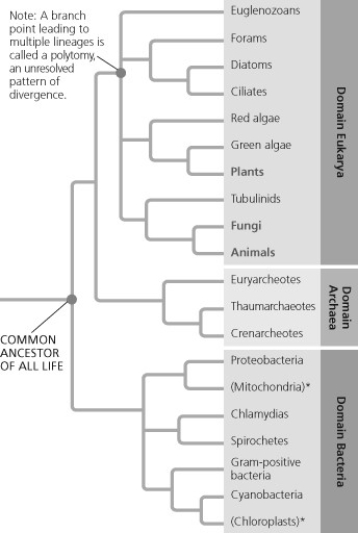
A phylogenetic tree is shown for the three domains of life (Eukarya, Archaea, and Bacteria) . The tree branches in two directions from the first point, labeled Common ancestor of all life. One branch leads in the direction of Eukarya and Archaea, and the other branch leads to Bacteria. The branch leading to Eukarya and Archaea divide, one branch leading to each domain. The branch leading to Eukarya divides into four branches. One leads to Euglenozoans, and the other three lead to branching points. The first leads to Forams in one direction, and another branching point in the other that leads to Diatoms and Ciliates. The second branching point leads to Red algae in one direction, and a branching point that leads to green algae and land plants in the other direction. The third branching point leads to amoebas in one direction, and a branching point that leads to fungi and animals in the other direction. Land plants, Fungi and Animals are all highlighted.
Examine the figure. If you were a graduate student trying to develop a thesis project that would resolve polytomies, which of the following groups would you study?
Definitions:
Jaundice
A yellowing of the skin and whites of the eyes caused by an accumulation of bilirubin in the blood.
Erythema
Redness of the skin caused by capillary dilation, often a sign of irritation, injury, or infection.
Estrogen
A group of hormones that play a crucial role in the development and regulation of the female reproductive system and secondary sexual characteristics.
Melanocyte-Stimulating Hormone
Peptide hormone secreted by the anterior pituitary; increases melanin production by melanocytes, making the skin darker in color.
Q1: In most fungi, karyogamy does not immediately
Q5: Why do RNA viruses appear to have
Q18: One predicted aspect of climate change is
Q25: Use the following description to answer the
Q35: Which of the following is (are) unique
Q36: Which of these are spore-producing structures?<br>A) sporophyte
Q47: The first cloned cat, called Carbon Copy,
Q49: In 2009, a flu pandemic was believed
Q51: A large population of laboratory animals has
Q65: One of the characteristics unique to animals